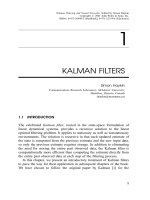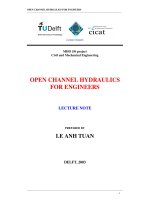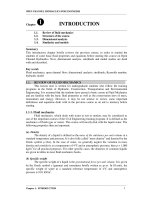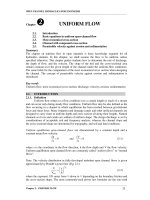- Trang chủ >>
- Khoa Học Tự Nhiên >>
- Vật lý
Tài liệu Open channel hydraulics for engineers. Chapter 3 hydraulics jump doc
Bạn đang xem bản rút gọn của tài liệu. Xem và tải ngay bản đầy đủ của tài liệu tại đây (228.55 KB, 24 trang )
OPEN CHANNEL HYDRAULICS FOR ENGINEERS
-----------------------------------------------------------------------------------------------------------------------------------
-----------------------------------------------------------------------------------------------------------------------------------
Chapter 3: HYDRAULIC JUMP
46
Chapter
HYDRAULIC JUMP
_________________________________________________________________________
3.1. Introduction
3.2. Specific energy
3.3. Depth of hydraulic jump
3.4. Types of hydraulic jump
3.5. Hydraulic jump formulas in terms of Froude-number
3.6. Submerged hydraulic jump
_________________________________________________________________________
Summary
In this chapter, the specific-energy concept is introduced and, then, the momentum
principle is applied to open-channel flows. The hydraulic jump and its types are defined
and classified. This chapter introduces how to determine the direct and submerged
hydraulics jump; their characteristics are presented.
Key words
Momentum; hydraulic jump; specific energy; critical; Froude-number; direct and
submerged jump
_________________________________________________________________________
3.1. INTRODUCTION
The most common application of the momentum equation in open-channel flow
deals with the analysis of the hydraulic jump. The rise in water level, which occurs during
the transformation of the unstable “rapid” or supercritical flow to the stable “tranquil” or
subcritical flow, is called hydraulic jump, manifesting itself as a standing wave. At the
place, where the hydraulic jump occurs, a lot of energy of the flowing liquid is dissipated
(mainly into heat energy). This hydraulic jump is said to be a dissipator of the surplus
energy of the water. Beyond the hydraulic jump, the water flows with a greater depth, and
therefore with a less velocity.
The hydraulic jump has many practical and useful applications. Among them are the
following:
Reduction of the energy and velocity downstream of a dam or chute in order to
minimize and control erosion of the channel bed.
Raising of the downstream water level in irrigation channels.
Acting as a mixing device for the addition and mixing of chemicals in industrial
and water and wastewater treatment plants. In natural channels the hydraulic jump
is also used to provide aeration of the water for pollution control purposes.
However, before dealing with the hydraulic jump in detail, it is necessary to understand the
principle of the so-called specific energy. We will apply this principle for explaining the
hydraulic jump phenomenon.
In the following the flow is supposed to be two-dimenssional.
OPEN CHANNEL HYDRAULICS FOR ENGINEERS
-----------------------------------------------------------------------------------------------------------------------------------
-----------------------------------------------------------------------------------------------------------------------------------
Chapter 3: HYDRAULIC JUMP
47
3.2. SPECIFIC ENERGY
3.2.1. Specific energy
Fig. 3.1. Specific-energy head of a flowing liquid
The specific-energy head, E, of a flowing liquid is defined as the energy head with respect
to a datum plane, for instance passing through the bottom of the channel as shown in Fig.
3.1. Mathematically, the specific-energy head reads as:
2
V
E h
2g
(3-1)
where h = depth of liquid flow, and
V = mean velocity of the liquid.
The specific-energy head can be written as:
2
s k
V
E h E E
2g
where E
s
= h = static-energy head (also known as potential energy head), and
2 2
k
2
V q
E
2g 2gh
= kinetic-energy head (depth averaged),
with q = discharge per unit width.
Plotting the specific-energy diagram for a channel (water depth h along the vertical axis),
may conveniently be done by first drawing the two (independent) curves for static energy
and kinetic energy and then adding the respective ordinates. The result is the required
specific-energy head curve.
Fig. 3.2. Specific-energy head curve
E
h
2
V
2 g
E
h
2
h
1
h
c
2
k
2
q
E
2gh
E
s
= h
45
C
h
depth
E
E
min
E vs h for q = constant
OPEN CHANNEL HYDRAULICS FOR ENGINEERS
-----------------------------------------------------------------------------------------------------------------------------------
-----------------------------------------------------------------------------------------------------------------------------------
Chapter 3: HYDRAULIC JUMP
48
Closer inspection shows, that the curve for the static-energy head (i.e. E
s
= h) is a straight
line through the origin, at 45 with the horizontal. The curve for the kinetic-energy head
(i.e.
2
k
2
q
E
2gh
), is a parabola (see Fig. 3.2.).
By adding the values of these two curves, at all the points, we get the specific-energy curve
as shown in Fig. 3.2.
3.2.2. Critical depth and critical velocity
We can see in the specific-energy diagram Fig. 3.2 that the specific energy is
minimum at point C. The depth of water in a channel, corresponding to the minimum
specific energy (as at C in this case) is known as critical depth. This depth can be found by
differentiating the specific-energy head equation and equating the result to zero. Or,
0
dh
dE
(3-2)
or, substituting
2
V
E h
2g
, we have:
0
g2
V
h
dh
d
2
(3-3)
With V =
h
q
, where q is the constant discharge per unit width,
2
2
d q
h 0
dh 2gh
0
gh
q
1
3
2
or
gh
V
gh
1
h
q
gh
q
1
2
2
2
3
2
g
V
h
2
(3-4)
Since the flow is (assumed to be) critical, the subcript c is added; therefore
g
V
h
2
c
c
(i) (3-5)
where h
c
= critical depth, and V
c
= critical velocity.
Replacing h by of h
c
and V by V
c
in the specific-energy head equation, the minimum
specific-energy head can be written as:
c
c
c
c
c
2
C
cmin
h
2
3
2
h
h
g2
gh
h
g2
V
hE
(3-6)
or the static-energy head becomes:
h
c
=
min
E
3
2
(ii) (3-7)
and the kinetic-energy head:
2
c
kc min min min
V 2 1
E E E E
2g 3 3
(iii) (3-8)
OPEN CHANNEL HYDRAULICS FOR ENGINEERS
-----------------------------------------------------------------------------------------------------------------------------------
-----------------------------------------------------------------------------------------------------------------------------------
Chapter 3: HYDRAULIC JUMP
49
We have seen in Eq. (3-5) that
2
2
c
c
c
q
h
V
h
g g
or
g
q
h
2
3
c
3
1
2
c
g
q
h
(3-9)
This is the equation for the critical depth, when the discharge per unit width through the
channel is given. Thus, the critical velocity corresponding to the depth of the channel is:
V
c
=
c
h
q
(3-10)
Example 3.1: A channel, 6 m wide, is discharging 20 m
3
/s of water. Determine the critical
depth and critical velocity, i.e. when the specific energy of the flowing water is minimum.
Solution:
Given: discharge: Q = 20 m
3
/s
channel width: b = 6 m
Discharge per unit width:
q =
b
Q
= 3.33 m
2
/s
Depth of water at minimum specific energy or critical depth:
h
c
=
3
1
2
g
q
= 1.04 m Ans.
and critical velocity:
V
c
=
c
h
q
= 3.20 m/s Ans.
3.2.3. Types of flows
Depending on
the
critical depth as well as the real, occurring depth of water in a
channel, three types of flow can be distinguished:
Tranquil flow
If the depth of water, in the channel is greater than the critical depth, the flow is called
tranquil or
subcritical.
Critical flow
If the depth of water in the channel is critical, the flow is called critical.
.
Rapid flow
If the depth of water in the channel is smaller than the critical depth, the flow is called
supercritical.
OPEN CHANNEL HYDRAULICS FOR ENGINEERS
-----------------------------------------------------------------------------------------------------------------------------------
-----------------------------------------------------------------------------------------------------------------------------------
Chapter 3: HYDRAULIC JUMP
50
Example 3.2: A channel of rectangular section, 7.5 m wide, is discharging water at a rate of
12 m
3
/s with an average velocity of 1.5 m/s. Find:
(a) Specific-energy head of the flowing water,
(b) Depth of water, when specific energy is minimum,
(c) Velocity of water, when specific energy is minimum,
(d) Minimum specific-energy head of the flowing water,
(e) Type of flow.
Solution:
Given: width of the channel: b = 7.5 m
discharge: Q = 12 m
3
/s
discharge per unit width:
b
Q
q
1.6 m
2
/s
average flow velocity: V = 1.5 m/s
depth of flowing water:
V
q
h
= 1.067 m
Specific-energy head of the flowing water
Let E = specific-energy head of the water.
Using the relation,
g2
V
hE
2
with the usual notations,
E = 1.182 m Ans.
Depth of water, when specific energy is minimum
Let h
c
= depth of water for minimum specific energy (i.e. the critical depth). Using the
relation,
3
1
2
c
g
q
h
h
c
= 0.639 m Ans.
Velocity of water, when specific energy is minimum
Let V
c
= velocity of water, when specific energy is minimum (i.e. the critical velocity).
Using the relation,
c
c
h
q
V
V
c
= 2.5 m/sec Ans.
Minimum specific-energy head of the flowing water
Let E
min
= minimum specific-energy head of the flowing water.
Using the relation,
g2
V
hE
2
c
cmin
with the usual notations,
E
min
= 0.958 m Ans.
Type of flow
Since the depth of water (1.067 m) is larger than the critical depth (0.639 m), the flow is
tranquil or subcritical. Ans.
OPEN CHANNEL HYDRAULICS FOR ENGINEERS
-----------------------------------------------------------------------------------------------------------------------------------
-----------------------------------------------------------------------------------------------------------------------------------
Chapter 3: HYDRAULIC JUMP
51
3.3. DEPTH OF HYDRAULIC JUMP
3.3.1. Concept
We can see in the specific-energy diagram (Fig. 3.2) that for a given specific
energy E, there are two possible depths h
1
and h
2
. The depth h
1
is smaller than the critical
depth, and h
2
is greater than the critical depth.
We also know that, when the water depth is smaller than the critical depth, the flow is
called a tranquil or subcritical flow. But when the depth is greater than the critical depth,
the flow is called a rapid or supercritical flow. It has been experimentally found, that the
rapid flow is an unstable type of flow, and does not continue on the downstream side. The
transformation from “rapid” flow into “tranquil” flow occurs by means of a so-called
“hydraulic jump”. A counterclockwise roller “rides” continously up the surface of the
jump, entraining air and contributing to the general complexity of the internal flow
patterns, as illustrated in Fig. 3.3. Turbulence is produced at the boundary between the
incoming jet and the roller. The kinetic energy of the turbulence is rapidly dissipated along
with the mean flow energy in the downstream direction, so that the turbulence kinetic
energy is small at the end of the jump. This complex flow situation is ideal for the
application of the momentum equation, because precise mathematical description of the
internal flow pattern is not possible.
3.3.2. Water rise in hydraulic jump
Consider two sections, on the upstream and downstream side of a jump, as shown in Fig.
3.3.
Fig. 3.3. Hydraulic jump
Let 1 - 1 = section on the upstream side of the hydraulic jump,
2 - 2 = section on the downstream side of the hydraulic jump,
h
1
= depth of flow at section 1 - 1,
V
1
= flow velocity at section 1 - 1,
h
2
, V
2
= corresponding values at section 2 - 2, and
q = discharge per unit width,
b
Q
q
, where Q = total discharge and b = width of channel and hydraulic jump
q = h
1
V
1
= h
2
V
2
Now consider the control volume of water between the sections 1-1 and 2-2, and apply the
law of conservation of momentum. Force F
1
on section 1-1:
1
2
1
2
h
2
h
1
V
1
V
2
F
1
F
2
OPEN CHANNEL HYDRAULICS FOR ENGINEERS
-----------------------------------------------------------------------------------------------------------------------------------
-----------------------------------------------------------------------------------------------------------------------------------
Chapter 3: HYDRAULIC JUMP
52
F
1
=
2
1 1
1
h .h
.(h 1)
2 2
(3-11)
where = g is the specific weight of the water.
Similarly, force F
2
on section 2-2:
F
2
=
2
2
.h
2
(3-12)
The horizontal net force F on the control volume, neglecting friction effects, acts backward
(because h
2
is greater than h
1
) and reads as:
F =
2 2
2 2
1 2
1 2 1 2
.h .h
F F (h h )
2 2 2
(3-13)
This force is responsible for change of velocity from V
1
to V
2
.
We know that this force is also equal to the change of momentum of the control volume:
Force = mass of water flowing per second change of velocity
F =
2 1
.q
(V V )
g
(3-14)
or
2 2
1 2
(h h )
2
=
2 1
.q
(V V )
g
2 2
1 2
(h h )
=
2
1 2
2 1
2 1 1 2
2.q 2q q q 2q h h
(V V )
g g h h g h h
or (h
1
+ h
2
)(h
1
– h
2
) =
2
1 2
1 2
2q
(h h )
g.h h
h
1
+ h
2
=
2
1 2
2q
g.h h
2
2
2 1 2
1
2q
h h h
gh
or
2
2
2 1 2
1
2q
h h h 0
gh
Solving the above quadratic equation for h
2
, we get:
2 2
1 1
2
1
h h 2q
h
2 4 gh
Taking only + sign and substituting q = h
1
V
1
:
2 2
1 1 1 1
2
h h 2h V
h
2 4 g
(3-15)
The “depth” of the hydraulic jump or the height of the standing wave is h
2
– h
1
.
Example 3.3: A discharge of 1000 l/s flows along a rectangular channel, 1.5 m wide. What
would be the critical depth in the channel? If a standing wave is to be formed at a point,
where the upstream depth is 180 mm, what would be the rise in the water level?
OPEN CHANNEL HYDRAULICS FOR ENGINEERS
-----------------------------------------------------------------------------------------------------------------------------------
-----------------------------------------------------------------------------------------------------------------------------------
Chapter 3: HYDRAULIC JUMP
53
Solution:
Given: discharge: Q = 1000 l/s = 1m
3
/s
channel width: b = 1.5 m
upstream depth: h
1
= 180 mm
Discharge per unit width:
q =
b
Q
= 0.67 m
2
/s
Critical depth in the channel:
h
c
=
3
1
2
g
q
= 0.358 m Ans.
Let h
2
be the depth of the flow on the downstream side of the standing wave or hydraulic
jump.
2 2
1 1
2
1
h h 2q
h
2 4 gh
= 0.63 m = 630 mm
Rise in water level h:
h = h
2
– h
1
= 450 mm Ans.
3.3.3. Energy loss due to hydraulic jump
The loss of energy head due to the occurrence of the hydraulic jump is the
difference between the specific-energy heads at sections 1-2 and 2-2. Mathematically,
E =
2 2
1 2
1 2 1 2
V V
E E h h
2g 2g
(3-16)
Example 3.4. A rectangular channel, 6 m wide, discharges 1200 l/s of water into a 6 m
wide apron, with zero slope, with a mean velocity of 6 m/s. What is the height of the jump?
How much power is absorbed in the jump?
Solution:
Given: channel width: b = 6 m
discharge: Q = 1200 l/s = 1.2 m
3
/s
mean velocity: V = 6 m/s
Q
q
b
= 0.2 m
2
/s
1
2
3
c
q
h
g
= 0.16 m
1c
c
q
V
h
= 1.25 m/s
V
1
> V
1c
: supercritical flow
occurrence of hydraulic jump.
OPEN CHANNEL HYDRAULICS FOR ENGINEERS
-----------------------------------------------------------------------------------------------------------------------------------
-----------------------------------------------------------------------------------------------------------------------------------
Chapter 3: HYDRAULIC JUMP
54
Height of hydraulic jump
Depth of water on the upstream side of the jump:
h
1
=
bV
Q
1
= 0.033 m
2 2
1 1 1 1
2
h h 2h V
h
2 4 g
= 0.476 m
Height of hydraulic jump h
jump
h
jump
= h
2
– h
1
= 0.443 m Ans.
Energy absorbed in the jump
Drop of specific-energy head:
E = E
1
– E
2
We know that due to the continuity of the discharge:
V
1
h
1
= V
2
h
2
or V
2
=
1 1
2
Vh
h
= 0.42 m/s
Now using the relation:
2 2
1 2
1 2 1 2
V V
E E h h
2g 2g
= 1.384 m Ans.
Dissipation of power in hydraulic jump:
1 2
P gQ E E
= 16.3 kW Ans.
3.3.4. Hydraulic jump features
The following features are associated with the transition from supercritical to subcritical
flow:
Highly turbulent flow with significantly dynamic velocity and pressure
components;
Pulsations of both pressure and velocity, and wave development downstream of the
jump;
Two-phase flow due to air entrainment;
Erosive pattern due to increased macro-scale vortex development;
Sound generation and energy dissipation as a result of turbulence production.
A hydraulic jump thus includes several features by which excess mechanical energy may
be dissipated into heat. The action of energy dissipation may even be amplified by
applying energy dissipators. These problems will be discussed in Chapter 6.









